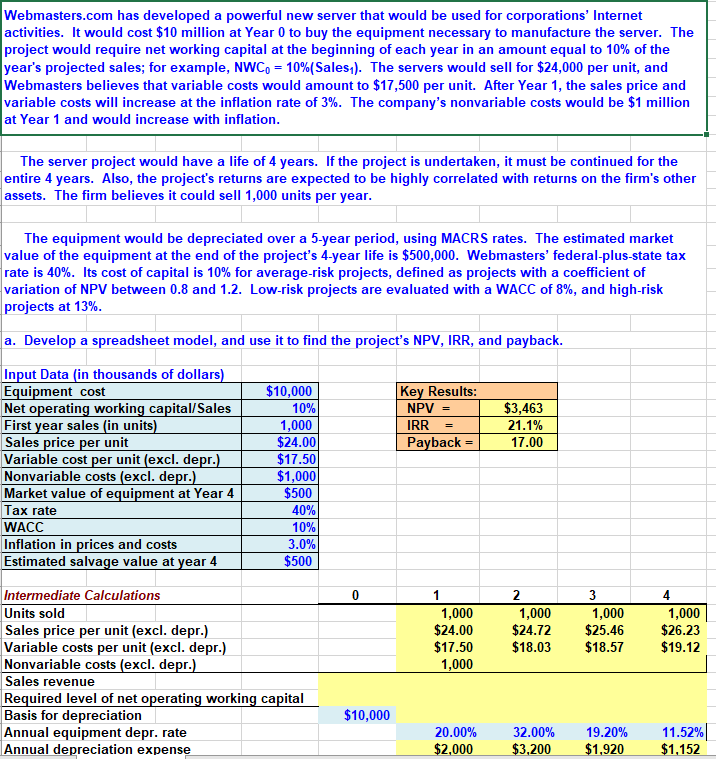
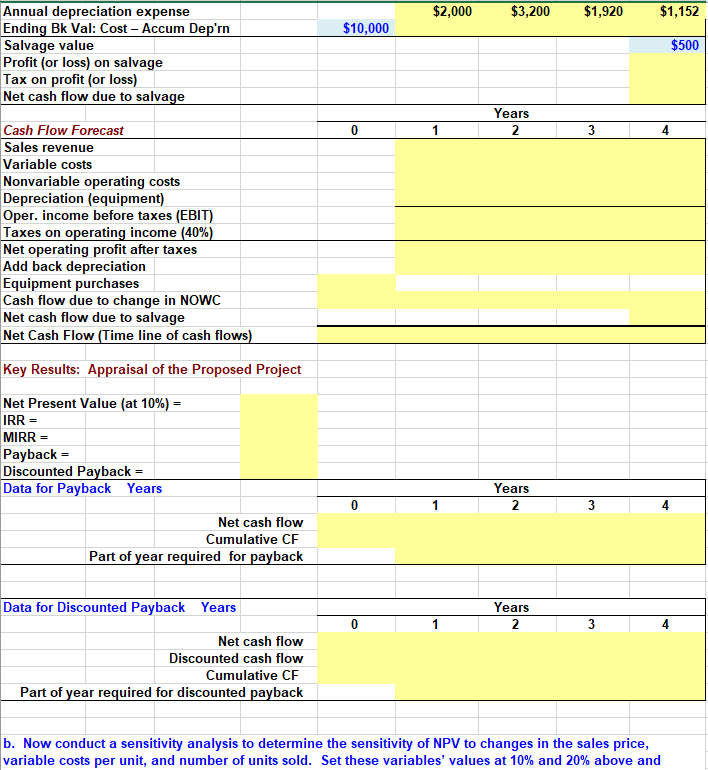
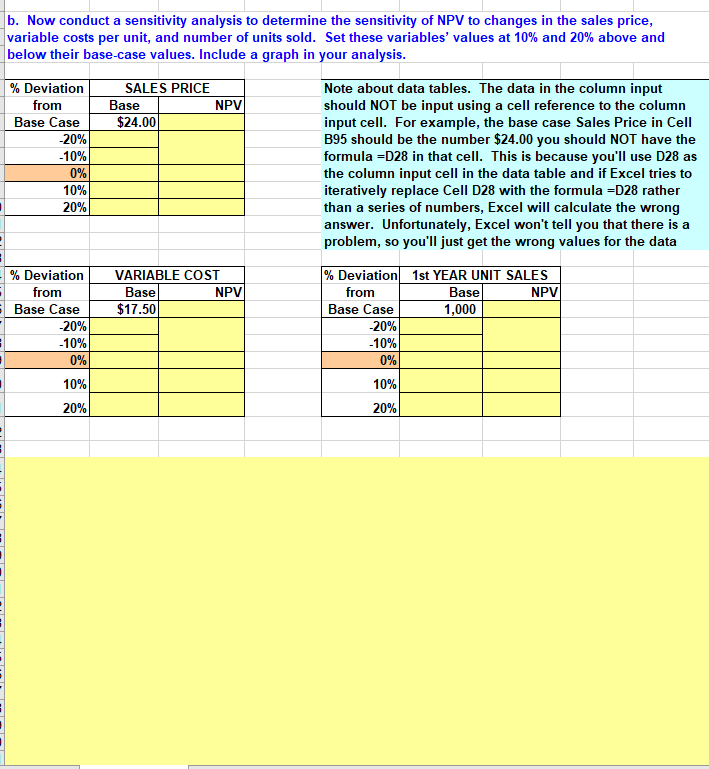
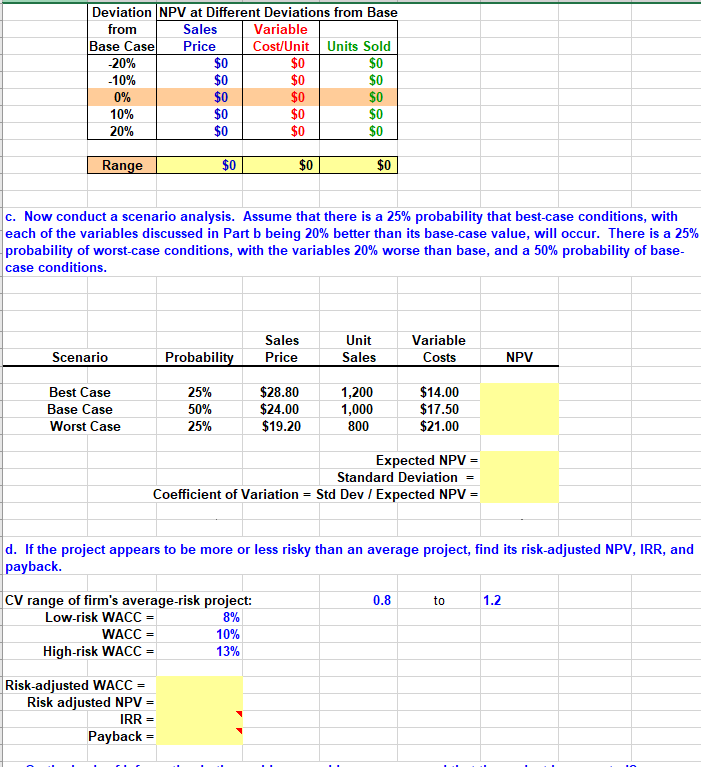
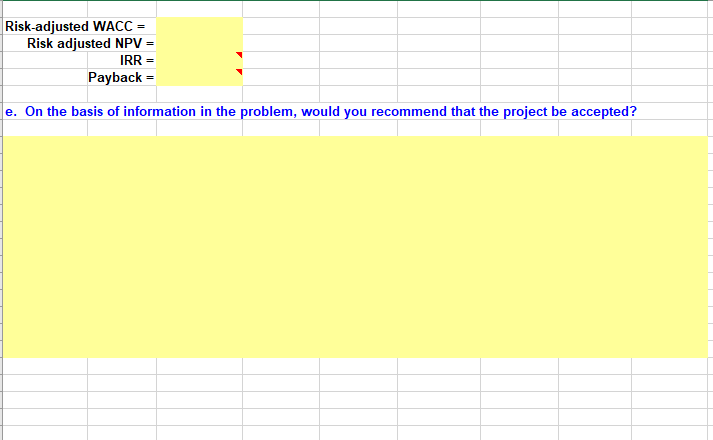
Webmasters.com has developed a powerful new server that would be used for corporations' Internet activities. It would cost $10 million at Year 0 to buy the equipment necessary to manufacture the server. The project would require net working capital at the beginning of each year in an amount equal to 10% of the year's projected sales; for example, NWC0-10%( Sales). The servers would sell for $24,000 per unit, and Webmasters believes that variable costs would amount to $17,500 per unit. After Year 1, the sales price and variable costs will increase at the inflation rate of 3%. The company's nonvariable costs would be $1 million at Year 1 and would increase with inflation The server project would have a life of 4 years. If the project is undertaken, it must be continued for the entire 4 years. Also, the project's returns are expected to be highly correlated with returns on the firm's other assets. The firm believes it could sell 1,000 units per vea The equipment would be depreciated over a 5-year period, using MACRS rates. The estimated market value of the equipment at the end of the project's 4-year life is $500,000. Webmasters' federal-plus-state tax rate is 40%. Its cost of capital is 10% for average-risk projects, defined as projects with a coefficient of variation of NPV between 0.8 and 1.2. Low-risk projects are evaluated with a WACC of 8%, and high-risk projects at 13% a. Develop a spreadsheet model, and use it to find the project's NPV, IRR, and payback Input Data (in thousands of dollars Equipment cost Net operating working capital/Sales First vear sales (in units Sales price per unit Variable cost per unit (excl. depr Nonvariable costs (excl. depr Market value of equipment at Year 4 Tax rate WACC Inflation in prices and costs Estimated salvage value at vear 4 $10,000 10% 1,000 $24.00 $17.50 $1,000 $500 40% 10% 3.0% $500 Key Results $3,463 21.1% 17.00 NPV IRR Payback- Intermediate Calculations Units sold Sales price per unit (excl. depr.) Variable costs per unit (excl. depr.) Nonvariable costs (excl. dep Sales revenue Required level of net operating working capital Basis for depreciation Annual equipment depr. rate Annual depreciation expense 2 4 1,000 $24.00 $17.50 1,000 1,000 24.72$25.46 $18.03 $18.57 1,000 1,000 $26.23 $19.12 $10,000 32.00% 19.20% $2,000 $3,200 $1,920 $1,152 20.00% 11.52% $3,200 $1,920 $1,152 Annual depreciation expense Ending Bk Val: Cost Accum Dep'rn Salvage value Profit (or loss) on salvage Tax on profit (or loss) Net cash flow due to salvage $2,000 $10,000 $500 Years Cash Flow Forecast Sales revenue Variable costs Nonvariable operating costs Depreciation (equipment) Oper. income before taxes (EBIT) Taxes on operating income (40% Net operating profit after taxes Add back depreciation Equipment purchases Cash flow due to change in NOWC Net cash flow due to salvage Net Cash Flow (Time line of cash flows 4 Key Results: Appraisal of the Proposed Project Net Present Value (at 10%- MIRR- Payback- Discounted Payback Data for Payback Years Years 2 Net cash flow Cumulative CF Part of year required for payback Data for Discounted Payback Years Years 4 Net cash flow Discounted cash flow Cumulative CF r required for discounted payback Part of yea b. Now conduct a sensitivity analysis to determine the sensitivity of NPV to changes in the sales price, variable costs per unit, and number of units sold. Set these variables' values at 10% and 20% above and b. Now conduct a sensitivity analysis to determine the sensitivity of NPV to changes in the sales price, variable costs per unit, and number of units sold. Set these variables' values at 10% and 20% above and below their base-case values. Include a graph in your analysis Deviation SALES PRICE Note about data tables. The data in the column input should NOT be input using a cell reference to the column input cell. For example, the base case Sales Price in Cell B95 should be the number $24.00 you should NOT have the formula -D28 in that cell. This is because you'll use D28 as the column input cell in the data table and if Excel tries to iteratively replace Cell D28 with the formula D28 rather than a series of numbers, Excel will calculate the wrong answer. Unfortunately, Excel won't tell you that there is a problem, so you'll just get the wrong values for the data from Base Case Base NPV $24.00 -20% 10% 0% 10% 20% Deviation VARIABLE COST % Deviation 1st YEAR UNIT SALES from Base Case Base $17.50 NPV from Base 1,000 NPV Base Case -20% 10% 0% 10% 20% -20% 10% 0% 10% 20% Deviation NPV at Different Deviations from Base Sales Base Case Price from Variable Cost/Unit Units Sold $0 $0 $0 $0 $0 $0 10% 10% 20% $0 $0 Range c. Now conduct a scenario analysis. Assume that there is a 25% probability that best-case conditions, with each of the variables discussed in Part b being 20% better than its base-case value, will occur. There is a 25% probability of worst-case conditions, with the variables 20% worse than base, and a 50% probability of base case conditions Sales Price Unit Sales Variable Costs Probability 25% 25% NPV Scenario 1,200 1,000 800 $14.00 $17.50 $21.00 Best Case Base Case Worst Case $28.80 $24.00 $19.20 Expected NPV Standard Deviation Std Dev I Expected NPV- Coefficient of Variation d. If the project appears to be more or less risky than an average project, find its risk-adjusted NPV, IRR, and payback CV range of firm's average-risk project: 0.8 1.2 Low-risk WACC 10% 13% WACC- High-risk WACC Risk-adjusted WACC- Risk adjusted NPV IRR Payback Risk-adjusted WACC- Risk adjusted NPV Payback- e. On the basis of information in the problem, would you recommend that the project be accepted? Webmasters.com has developed a powerful new server that would be used for corporations' Internet activities. It would cost $10 million at Year 0 to buy the equipment necessary to manufacture the server. The project would require net working capital at the beginning of each year in an amount equal to 10% of the year's projected sales; for example, NWC0-10%( Sales). The servers would sell for $24,000 per unit, and Webmasters believes that variable costs would amount to $17,500 per unit. After Year 1, the sales price and variable costs will increase at the inflation rate of 3%. The company's nonvariable costs would be $1 million at Year 1 and would increase with inflation The server project would have a life of 4 years. If the project is undertaken, it must be continued for the entire 4 years. Also, the project's returns are expected to be highly correlated with returns on the firm's other assets. The firm believes it could sell 1,000 units per vea The equipment would be depreciated over a 5-year period, using MACRS rates. The estimated market value of the equipment at the end of the project's 4-year life is $500,000. Webmasters' federal-plus-state tax rate is 40%. Its cost of capital is 10% for average-risk projects, defined as projects with a coefficient of variation of NPV between 0.8 and 1.2. Low-risk projects are evaluated with a WACC of 8%, and high-risk projects at 13% a. Develop a spreadsheet model, and use it to find the project's NPV, IRR, and payback Input Data (in thousands of dollars Equipment cost Net operating working capital/Sales First vear sales (in units Sales price per unit Variable cost per unit (excl. depr Nonvariable costs (excl. depr Market value of equipment at Year 4 Tax rate WACC Inflation in prices and costs Estimated salvage value at vear 4 $10,000 10% 1,000 $24.00 $17.50 $1,000 $500 40% 10% 3.0% $500 Key Results $3,463 21.1% 17.00 NPV IRR Payback- Intermediate Calculations Units sold Sales price per unit (excl. depr.) Variable costs per unit (excl. depr.) Nonvariable costs (excl. dep Sales revenue Required level of net operating working capital Basis for depreciation Annual equipment depr. rate Annual depreciation expense 2 4 1,000 $24.00 $17.50 1,000 1,000 24.72$25.46 $18.03 $18.57 1,000 1,000 $26.23 $19.12 $10,000 32.00% 19.20% $2,000 $3,200 $1,920 $1,152 20.00% 11.52% $3,200 $1,920 $1,152 Annual depreciation expense Ending Bk Val: Cost Accum Dep'rn Salvage value Profit (or loss) on salvage Tax on profit (or loss) Net cash flow due to salvage $2,000 $10,000 $500 Years Cash Flow Forecast Sales revenue Variable costs Nonvariable operating costs Depreciation (equipment) Oper. income before taxes (EBIT) Taxes on operating income (40% Net operating profit after taxes Add back depreciation Equipment purchases Cash flow due to change in NOWC Net cash flow due to salvage Net Cash Flow (Time line of cash flows 4 Key Results: Appraisal of the Proposed Project Net Present Value (at 10%- MIRR- Payback- Discounted Payback Data for Payback Years Years 2 Net cash flow Cumulative CF Part of year required for payback Data for Discounted Payback Years Years 4 Net cash flow Discounted cash flow Cumulative CF r required for discounted payback Part of yea b. Now conduct a sensitivity analysis to determine the sensitivity of NPV to changes in the sales price, variable costs per unit, and number of units sold. Set these variables' values at 10% and 20% above and b. Now conduct a sensitivity analysis to determine the sensitivity of NPV to changes in the sales price, variable costs per unit, and number of units sold. Set these variables' values at 10% and 20% above and below their base-case values. Include a graph in your analysis Deviation SALES PRICE Note about data tables. The data in the column input should NOT be input using a cell reference to the column input cell. For example, the base case Sales Price in Cell B95 should be the number $24.00 you should NOT have the formula -D28 in that cell. This is because you'll use D28 as the column input cell in the data table and if Excel tries to iteratively replace Cell D28 with the formula D28 rather than a series of numbers, Excel will calculate the wrong answer. Unfortunately, Excel won't tell you that there is a problem, so you'll just get the wrong values for the data from Base Case Base NPV $24.00 -20% 10% 0% 10% 20% Deviation VARIABLE COST % Deviation 1st YEAR UNIT SALES from Base Case Base $17.50 NPV from Base 1,000 NPV Base Case -20% 10% 0% 10% 20% -20% 10% 0% 10% 20% Deviation NPV at Different Deviations from Base Sales Base Case Price from Variable Cost/Unit Units Sold $0 $0 $0 $0 $0 $0 10% 10% 20% $0 $0 Range c. Now conduct a scenario analysis. Assume that there is a 25% probability that best-case conditions, with each of the variables discussed in Part b being 20% better than its base-case value, will occur. There is a 25% probability of worst-case conditions, with the variables 20% worse than base, and a 50% probability of base case conditions Sales Price Unit Sales Variable Costs Probability 25% 25% NPV Scenario 1,200 1,000 800 $14.00 $17.50 $21.00 Best Case Base Case Worst Case $28.80 $24.00 $19.20 Expected NPV Standard Deviation Std Dev I Expected NPV- Coefficient of Variation d. If the project appears to be more or less risky than an average project, find its risk-adjusted NPV, IRR, and payback CV range of firm's average-risk project: 0.8 1.2 Low-risk WACC 10% 13% WACC- High-risk WACC Risk-adjusted WACC- Risk adjusted NPV IRR Payback Risk-adjusted WACC- Risk adjusted NPV Payback- e. On the basis of information in the problem, would you recommend that the project be accepted











